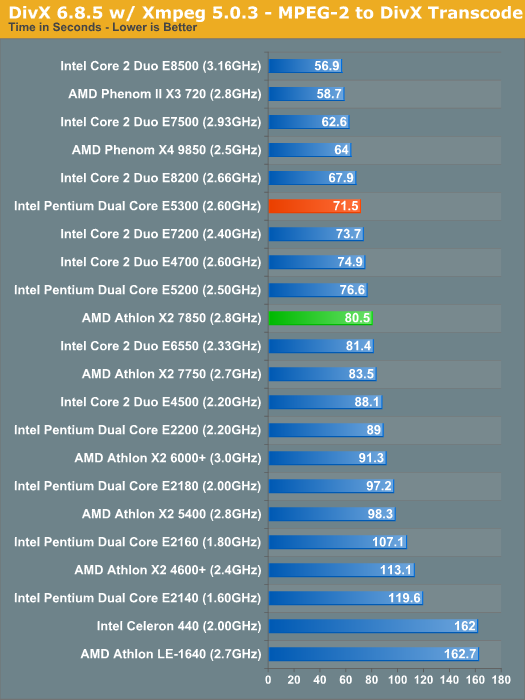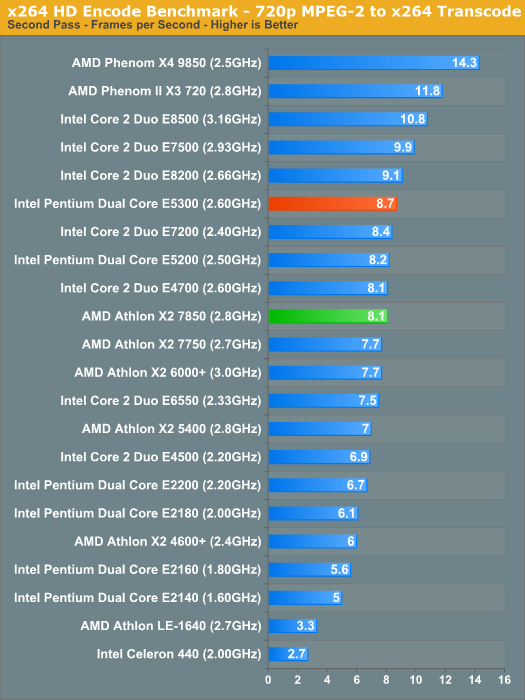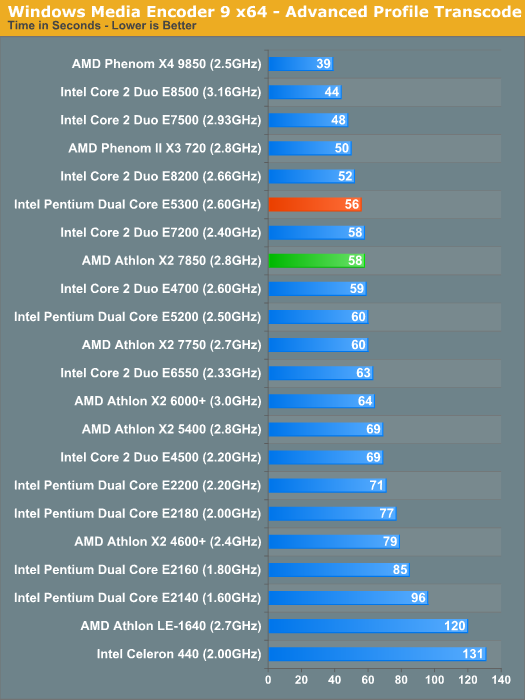AMD Athlon X2 7850 vs. Intel Pentium E5300: Choosing the Best $70 CPU
by Anand Lal Shimpi on April 28, 2009 11:00 AM EST- Posted in
- CPUs
DivX 8.5.3 with Xmpeg 5.0.3
Our DivX test is the same DivX / XMpeg 5.03 test we've run for the past few years now, the 1080p source file is encoded using the unconstrained DivX profile, quality/performance is set balanced at 5 and enhanced multithreading is enabled:

The original Phenom was significantly weaker than Intel’s Core 2 at DivX encoding, thus the Athlon X2 vs. Pentium comparison here isn’t very favorable for AMD. The E5300 is 11% faster than the 7850 here. Even the E5200 is a better choice for DivX encoding.
x264 HD Video Encoding Performance
Graysky's x264 HD test uses the publicly available x264 codec (open source alternative to H.264) to encode a 4Mbps 720p MPEG-2 source. The focus here is on quality rather than speed, thus the benchmark uses a 2-pass encode and reports the average frame rate in each pass.


The x264 HD encode test is slightly different depending on what pass you look at. The first pass of the x264 HD encode actually has a number of unaligned loads, which penalizes Intel’s Core architecture - something fixed in Nehalem. The second and more CPU intensive pass is where Intel sees a 7.4% performance advantage over AMD. Despite the small advantage in the first pass of the encode, the win goes to Intel for a larger and more meaningful advantage in the second pass.
Windows Media Encoder 9 x64 Advanced Profile
In order to be codec agnostic we've got a Windows Media Encoder benchmark looking at the same sort of thing we've been doing in the DivX and x264 tests, but using WME instead.

Our final pure encode test once again has the E5300 ahead of the Athlon X2 7850, but by only a 3.4% margin.










55 Comments
View All Comments
v12v12 - Tuesday, April 28, 2009 - link
What does personal mud slinging have to do with my points? Please debate them, if you can?Doc01 - Tuesday, July 27, 2010 - link
Athlon has surpassed all expectations, Athlon outside competition.<a href="http://www.salesgeneric.net">http://www.sa...
just4U - Tuesday, April 28, 2009 - link
I think overclocks are a non issue with the 5300. Why would anyone buy it over a 5200 which is already a proven performer. Not like the 5300 could actually outdue it... Anyway..I was faced with a decision on a couple of cheap builds. (no overclocking) The 5200 or the 7750. In the end I opted for the 7750 for a few reasons..
I kinda felt that the chips were comparable overall.. but a key deciding factor was the motherboards used. The 780G chipset is just way to tempting at such a low low price for a budget build that it sort of trumps Intel's cpu/mb considerations. Atleast in my opinion... am I wrong?
TA152H - Tuesday, April 28, 2009 - link
Anand, you mention the Pentium has a one cycle faster L1 cache, but my understanding is they are both three cycles. I know the K7 and K8 were three cycles. Did AMD slow down the L1 cache on the Phenom's?A few other things to consider. The L2 cache on the AMD is exclusive, Intel's is inclusive. But, the L1 cache of AMD processors is not really 128K, since they pad instructions for easier decoding, but I guess that's just nitpicking.
I'm really curious about the L1 cache latency though. Can you let us know if the Phenom is now 4 clock cycles? It's an ugly trend we're seeing, with the L1 cache latency still going up, except for the Itanium. Which, as we all know, will replace x86. Hmmmm, I guess Intel missed on that prediction :-P .
Anand Lal Shimpi - Tuesday, April 28, 2009 - link
You know, I didn't even catch that until now. I ran a quick latency test that reported 4 cycles but the original Phenom (and Phenom II) both have a 3 cycle L1. I've got a message in to AMD to see if the benchmark reported incorrectly or if something has changed. I'm guessing it's just a benchmark error but I want to confirm, I've seen stranger things happen :)Intel found that the 4 cycle L1 in Nehalem cost them ~2% in performance, but it was necessary to keep increasing clock speeds. I'd pay ~2% :)
Take care,
Anand
TA152H - Tuesday, April 28, 2009 - link
I was under the impression the reason Intel increased L1 cache latency was so they could use a lower power technology, and save some power.I heard the number was around 3 to 4 percentage loss in performance, but I guess it always depends on workload and who in Intel is saying it.
But, the whole setup seems strange to me now. Typically, when you go to the 3-level cache hierarchy, you see a smaller, faster L1 cache, not a very slow one like the Nehalem has. Especially with such a small, fast L2 cache, and the fact the L1 is inclusive in it, I'm not clear why they didn't cut the L1 cache in half, and lower the latency. You'd cut costs, you'd cut power, and I'm not sure you'd lose any performance with a 32K L1 cache with three cycles, instead of a 64K with four, when you have a 10 cycle L2 cache behind it. A non-exclusive L2 cache that is only four times the size of the L1 cache seems like an aberration to me. I wouldn't be surprised if this changed in some way for the next release, but I have no information on it at all.
But, mathematically, if you could but the L1 cache to three cycles by going to 32K, that would mean you'd get better performance for reads up to the 32K mark by one cycle, and worse by six cycles for anything between 32K and 64K. Typically, you'd expect this to favor the smaller cache, since the likelihood of it falling outside the 32K but within the 64K is probably less than 1/6 the chance of it falling inside the 32K. Really, we should be halving it, since it's instruction and data, but I think it's still true. On top of this, you'd always have lower power, and you'd always have a smaller die, and generate less heat. And you wouldn't have that crazy four to one L2 to L1 ratio.
But, the Nehalem has great performance, so obviously Intel knew what they were doing. Maybe they were able to hide the latency well beyond simple mathematics like I used above, or maybe cutting it to three cycles would have been difficult (very hard to imagine since it's working on the Penryn with 64K, and the clock speeds aren't so different). I wish I knew :-P .
Thanks for your response.
Anand Lal Shimpi - Tuesday, April 28, 2009 - link
This is what I wrote in my original Nehalem Architecture piece:"The L1 cache is the same size as what we have in Penryn, but it’s actually slower (4 cycles vs. 3 cycles). Intel slowed down the L1 cache as it was gating clock speed, especially as the chip grew in size and complexity. Intel estimated a 2 - 3% performance hit due to the higher latency L1 cache in Nehalem."
I believe Ronak Singhal was the source on that, the chief architect behind Nehalem.
I suspect the decision to stick with a 64KB L1 (I + D) instead of shrinking it has to do with basic statistics. There's no way the L1 is going to catch all of anything, but the whole idea behind the cache hierarchy is to catch a high enough percentage of data/instructions to limit the number of trips to lower levels of memory.
It's not impossible to build a 64KB 3-cycle L1, but if Ronak is correct then even a smaller L1 would not negate the need to make it a 4-cycle cache - the L1 was gating clock speed.
I think Intel found the right L1 size for its chips and the right L2 size. The L3 is up in the air at this point. Ronak said he wanted a larger cache, but definitely no less than 2MB per core (8MB for a quad-core).
Take care,
Anand
f4phantom2500 - Tuesday, April 28, 2009 - link
seriously, most people who come to anandtech and look at these things are at least aware of overclocking, if not overclockers themselves. whenever i build desktop rigs for myself i always go for the cheap "low end" chips and overclock them. the e5300 is an excellent example. honestly i'd expect it to completely decimate the 7850 in all ways if they were overclocked, but they should definitely have put it in this review, as there are 2 people who buy these types cheap cpus:1. people who do basic stuff and don't really care anyway
2. people who overclock
and people who overclock would most likely constitute the majority of the readers of a comparison between the two chips, because if you didn't care about performance that much then there aren't too many reasons why you'd bother reading this review.
sprockkets - Tuesday, April 28, 2009 - link
For me, it comes down to whether I want a Zotac mini ITX board based on the 8200 or 9300 chip. While the AMD one is cheaper, they neglected to put in a HDMI and SPDIF ports on it, so, I have to go for the Intel board.Besides, they have a small heatsink fan combo. I assume the AMD one is bigger, but of course, it mounts much easier and better than Intel's setup.
leexgx - Sunday, May 3, 2009 - link
the intel one make so little heat does not need an big heatsink, i going to have to start useing intel CPUs for my basic systems soon as where i get me cpus form only stock 2.7ghz amd X2 CPUs or the heat moster 7750